VAD program expansion saving more lives
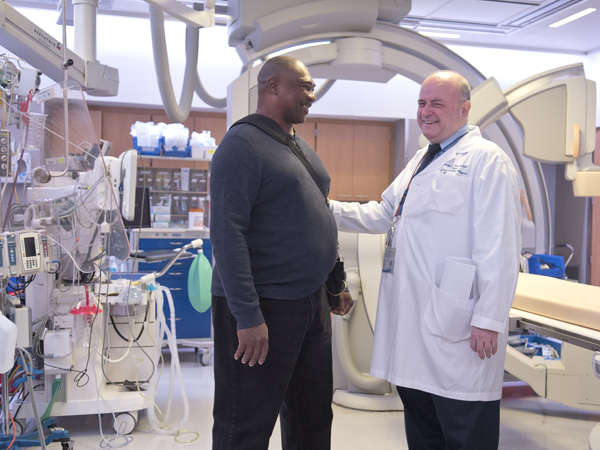
Published in News Stories on October 24, 2016
There's a spring in Jonathan Battle's step when the 54-year-old arrives at a Jackson nonprofit to take classes for a high school equivalency diploma.
He's a different man than he was before March 23 of this year. “I felt like I was in misery. I didn't have any energy to do anything,” Battle said.
Battle dresses casually for class at the Prosperity Center of Greater Jackson with the exception of one accessory, a satchel-type bag slung across his shoulder that he wears at all times. It contains a power pack and a backup that charges his left ventricular assist device, or LVAD.
The LVAD is a life-saving pump, implanted in his chest at the University of Mississippi Medical Center, that pumps blood to take over the work from his weakened and damaged heart. UMMC is the sole medical facility in the state that offers patients ventricular assist devices.
“My body feels great, but that bag reminds me that I'm sick,” said Battle, a patient at the Medical Center's University Heart. “I'm waiting for the day of my heart transplant, but for now, I feel great with the VAD. My heart feels strong.”
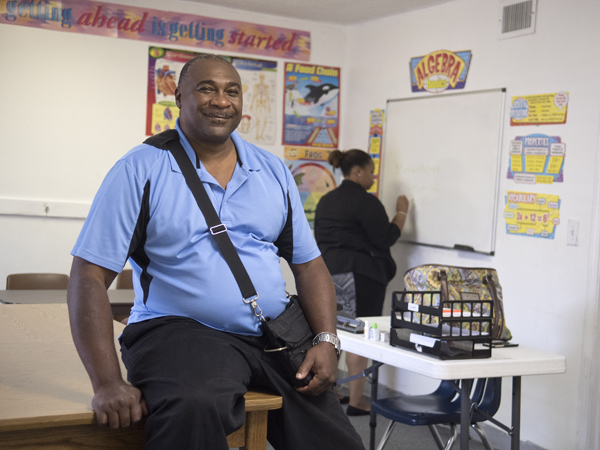
Battle is seeking his GED at the Prosperity Center of Greater Jackson.
Before University Heart recently earned The Joint Commission's Gold Seal of Approval for disease-specific certification of its ventricular assist device program, only patients who were candidates for transplants could receive the implant. The Joint Commission designation, however, means the pool of potential patients who could benefit from VAD therapy is broadened.
That includes what's known as LVAD “destination therapy,” an alternative for end-stage heart failure patients who aren't candidates for heart transplantation. Until he gets in shape for a transplant, Battle is walking that path.
“This helps sustain someone's life who will unlikely be able to have a heart transplant,” said Tom Wills, executive director of University Heart. “It allows us to treat more patients who would not typically be treated here.”
Dr. Anthony Panos, professor of cardiothoracic surgery, implanted Battle's LVAD. “It's a great treatment, and we're in a unique position to help many people,” he said.
VAD therapy provides long-term cardiac support for patients whose hearts are too damaged or diseased to provide adequate circulation to the body's tissues. VAD therapy, heart transplant, and heart valve services are part of the mission of University Heart, a diagnostic and treatment facility on the UMMC campus that offers patients a full scope of heart care services under one roof.
Because Mississippi has high rates of obesity, hypertension and heart disease, Panos said, the need for such therapy is great. “Heart failure is the final common condition patients have with many forms of heart disease,” he said.
UMMC first performed the LVAD procedure in 2010. Eight devices have been implanted so far this year, including two LVADs meant for destination therapy. Wills said the volume is anticipated to double with the certification.
The LVAD doesn't replace the heart, but it helps relieve symptoms that include being constantly tired or short of breath. It maintains or improves other organ function, and it better allows the patient to exercise and take part in cardiac rehabilitation.
But most importantly, it can mean the difference between life and death for someone whose heart is simply too weak to pump on its own, whose organ needs a rest after open-heart surgery, or who needs it to keep their heart pumping before an organ is found for transplant.
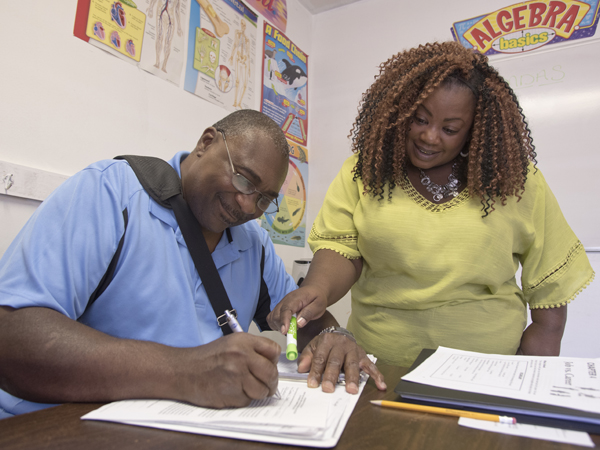
Kimberly Knight, education coordinator for GED classes at the Prosperity Center of Greater Jackson, checks Battle's work.
A weight gain is keeping Battle off the waiting list for a heart. “If I lose 80 pounds, that will put me at 200,” he said. “I only have to lose 30 for the transplant, but I want to lose 80.”
How the LVAD pump works: One end hooks up to the left ventricle, the heart chamber that pumps blood out of the lungs and into the body. The other end is hooked up to the aorta. The device assists the heart in pumping oxygen-rich blood through the body.
A tube passes from the device through the skin, and the outside portion of the tube is covered with a substance that allows skin at the site to heal and regrow. The pump is supported by a computer controller, power pack and a reserve power pack worn outside the body in a satchel-like carrier.
UMMC's VAD program underwent a rigorous on-site review by an expert Joint Commission reviewer. That person evaluated the program for compliance with the requirements for The Joint Commission's disease-specific care certification program, as well as ventricular assist device destination therapy-specific standards.
The review also took in UMMC's guidelines for its VAD program, education of both patients and staff on the procedure, the program's performance, and the multidisciplinary team's care given to patients receiving the VAD surgery.
“Our goal is to have an excellent program to offer Mississippians,” Panos said. “This (certification) opens the door to a much larger population. People no longer have to travel anywhere else for this. They can get the full range of services here.”
LVAD therapy can extend a patient's life for five years or more, Panos said, and the technology continues to evolve and improve. “There are new devices in development, and as they come online, we will offer them here.”
Battle works hard in his GED class, said Kimberly Knight, Battle's teacher and education coordinator at the Prosperity Center, an arm of the social and economic revitalization organization Midtown Partners.
“The students have a nickname for him. They call him 'Old School,'” she said. “He's the oldest, and he gives us a mixture of age in our group. He brings a lot of wisdom to the class.”
His LVAD, Battle says, “gives me a fresh start.” That includes resurrecting his former career in home construction. “My goal is to get my GED, then to become a licensed contractor so that I can start my business back up, but to do it right this time,” Battle said.
“I have a new outlook on life. (Earning a GED) is something I should have done when I was younger. But my heart is strong, and I have something to look forward to.”
Photos
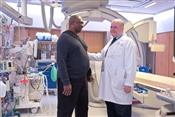 | High Resolution Medium Resolution Low Resolution |
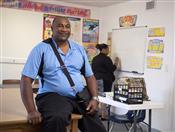 | High Resolution Medium Resolution Low Resolution |
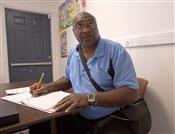 | High Resolution Medium Resolution Low Resolution |
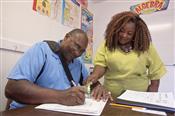 | High Resolution Medium Resolution Low Resolution |


